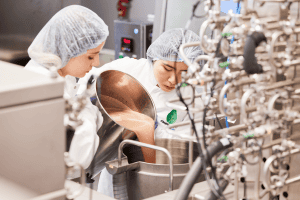For 150 years, AAK has been transforming plant-based oils and fats into functional ingredients for food, whether it’s to create the right snap for a chocolate bar or infant formula that mimics breast milk. However, in corners of its R&D laboratories today, you’ll find some white coats turning their hands to very different projects.
Like an upstream Willy Wonka, the Swedish company is applying its expertise in tinkering with chocolate melting points and crystallization to candles and more industrial solutions…think food-grade lubricants, coffee-cup liners, and biofuels. Exactly what AAK is working on remains hush-hush for now.

“Given AAK is well established in food ingredients, we are starting to look a bit outside of that. With some of the industries it’s like…wait a minute, with our knowledge we could do that,” CEO Johan Westman said in an interview with chemicalESG.
“We have a few targets. When we have had our breakthroughs, we’ll speak about it.”
Westman’s roots are in the automotive supply chain, somewhat bridging the gap to an area like lubricants. After leaving consultancy firm Arthur D Little, he had a quick succession to CEO at FinnvedenBulten, a supplier of cabriolet roofs, and went on to lead another auto OEM supplier, Shiloh Industries. He joined AAK seven years ago.
In some ways, AAK is difficult to place. It doesn’t produce frying oil and trade agricultural commodities like an ADM, yet it still crushes a little rapeseed in Sweden for legacy reasons. Additionally, it is backward integrated into shea micro-farming in Africa so as “to skip the middle men.” While it buys feedstock from the likes of Cargill, it also competes with them in a specific market. Then you have some of the flavor-and-fragrance houses venturing into the specialty fats space, albeit in a very limited capacity.

But at its very core, the Malmö-based company is a supplier of refined oils and a splicer and dicer of fat molecules to create functional food ingredients.
Palm oil, for example, can be fractionated to separate the harder stearin from the softer olein to create bespoke effects. AAK’s ingredients can prolong shelf life or separate layers in energy bars.
Having seen the price of cocoa butter soar this year, makers of skin lotions and chocolate are turning to shea mixed with palm oil as a lower-cost equivalent. Enzymatic processes are also used in areas like infant formula.
“Many of our suppliers are, technically, a competitor in certain components but we are unique in being so broad,” Westman said. A closer comparison is Japan’s Fuji Oil.
Despite Westman’s auto past, he currently regards more industrial applications like lubricants as something of a side hustle for now. There is growing pressure among customers to move away from paraffin and petrochemicals to more sustainable and lower CO2 alternatives, but the functional fats versus fossil fuels battle is still in the early stages.
“It’s not the No. 1 play we have,” he said. “It’s interesting to build smaller legs to stand on as eventually they become bigger legs. Do we have the skills? Yes.
“But we’re not naive. You need to master the space, and we are up against some pretty damn good chemists. Without being overly confident in our ability to beat the others, it’s quite promising.”

